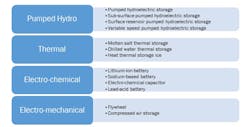The energy-storage market is the focal point of technological advances backed by the need for product innovation. The electric grid is one of the most complex systems to operate as it requires the power demand and supply to be equal at every moment of time. Therefore, instant adjustment in power supply as per fluctuation in demand is necessary to maintain grid stability.
Large consumers of electricity, such as industries and commercial spaces, require uninterrupted power supplies. The use of energy-storage systems in such areas can eliminate the risk of any interruption or damage caused in local utility’s supply.
Energy-storage systems mainly consist of different types of methods and technologies that can be utilized to store various forms of energy. Energy-storage systems work by capturing the available form of required energy resource and store it for future use. The following sections analyze the effectiveness, current status, and future scope of some of the major energy-storage technologies mentioned in Figure 1.
1. Types of technologies with their sub-types utilized for energy-storage systems.
Pumped Hydroelectric Storage
Pumped-hydroelectric-storage systems generate electricity similarly to a conventional hydropower station. However, in pumped hydroelectric storage, the same water is used for power generation again. While water is pumped to an upper reservoir during low power demand, the stored water is utilized for excess power generation during peak power demand.
It’s the most widely deployed storage technology on a large scale, globally, which accounted for over 85% of the total energy-storage systems market in 2018. This concept was commercialized in the year 1890 and has now become a mature technology. It provides a major advantage of a longer lifetime in the range of 45 years to 60 years as well as a longer storage period as compared to other available technologies.
Molten-Salt Thermal Energy Storage
Molten-salt thermal storage is the most widely used method for thermal energy storage as compared to its available counterparts. It works by storing heat energy, which can be transformed into superheated steam, to run steam turbines in order to generate electricity.
This technology is extensively utilized in solar thermal power plants in which molten salts are used as a heat transfer fluid and to store the excess amount of heat energy. Molten-salt thermal storage technology helps solar thermal power plants to function as a base load power plant.
Commercialization of a new type of molten salt to enhance the efficiency and performance of molten-salt thermal storage is expected in the future. For instance, the National Renewable Energy Laboratory (NREL) received $7 million (USD) of funding from the U.S. Department of Energy (DoE) in 2018 for research related to a new type of molten salt that can operate even at extreme temperatures of around 700°C.
Flywheel
Flywheel is a type of electromechanical energy-storage system that utilizes electric energy as input, which is then stored as kinetic energy in a spinning mass such as a rotor. This rotor is made to spin under an enclosure with much less friction. In case of power requirements, stored kinetic energy in the flywheel is converted into electrical energy.
Flywheel energy storage has major advantages such as fast charge capability, long lifecycle, and low maintenance requirements. Currently, flywheels for energy storage are utilized for applications in sectors such as power, aerospace, and telecommunications.
R&D activities are underway to improve the performance of flywheel energy-storage technology. For instance, research regarding development for new materials possessing low density and high strength, which will provide higher energy densities, is being conducted by various organizations and institutions.
Moreover, research is underway regarding the use of high-temperature superconducting materials in the bearings. Superconducting bearings could significantly enhance the performance of the overall system by reducing friction loss in flywheels.
Lithium-Ion Battery Storage
Lithium-ion battery storage systems represent one form of electrochemical energy-storage system. Globally, electrochemical energy storage market accounted for over 3,200 MW of installed capacity in 2018, of which lithium-ion battery storage accounted for the dominant share.
Lithium-ion batteries store power in the form of chemical energy. These batteries offer major advantages such as low self-discharge rate, high round-trip efficiency, and longer lifetime.
Economies of scale in lithium-ion battery manufacturing has resulted in more than 70% decline in their cost over the last decade. As a result, it’s become the battery technology of choice for energy storage.
Research is ongoing to further enhance the amount of energy density for lithium-ion batteries. For instance, high-voltage electrolytes and silicon anodes are some of the techniques being looked at to further increase energy density of these batteries.
Moreover, studies are underway to explore new approaches for better utilization of lithium as a material specifically for energy storage. For instance, the lithium-air battery offers great potential in terms of energy and power density when compared to other battery storage systems.
Sodium-Based Battery Storage
Another type of electrochemical energy-storage system—sodium-based battery storage—is considered as a future alternative to lithium-ion based battery storage. The main reason for the move toward the sodium-based battery is simply because sodium is one of the most abundantly available resources in the Earth’s crust. And, of course, sodium can be recovered from seawater.
Moreover, chemical composition of sodium provides inherent protection to the battery in case of overcharging. This fact makes sodium-based battery storage safer than its lithium-ion-based counterpart.
One possible drawback is that sodium-based battery storage is expected to be physically heavier than lithium-ion-based battery storage. Nonetheless, R&D efforts are underway to commercialize sodium-based batteries in the near future owing to their aforementioned advantages. This option will provide low-cost storage facilities for large-scale solar and wind projects in the future.
Hybrid Energy Storage
Hybrid energy-storage systems combine several different energy-storage technologies to form a single energy-storage system. The potential of these systems is the advantage of better reliability and availability, as well as an increase in overall efficiency.
Currently, some of the types of hybrid energy-storage systems under pilot-stage implementation are thermal/battery, battery/battery, and ultracapacitor/battery. For instance, a utility in Bremen, Germany, contracted with AEG Power Solutions in 2018 to build a hybrid energy-storage system. This system will combine electrochemical and thermal energy-storage technology, with the goal of aiding the utility’s grid-frequency regulation.
In October 2017, redT provided a hybrid energy-storage system to Monash University in Australia. This system utilizes a battery/battery type of hybrid energy-storage system that leverages a vanadium-based flow battery and lithium-ion-based battery. In this system, vanadium-based flow battery provides majority of power, while Li-ion battery provides power during a surge in power demand.
Though such hybrid energy-storage systems offer various advantages over individual energy-storage technologies, these systems will require unique power-management systems for different configurations of these technologies. As such, R&D is underway to develop new combinations and better hybrid power-management systems.
Comparing the Candidates
Comparisons of different energy-storage technologies are based on energy-storing capacity and the time required for discharge. Therefore, a particular technology can be selected for performing different energy-supply services such as reserve and response, transmission and distribution support, and bulk power supply.
Figure 2 compares the above-mentioned energy storage technologies. Results show that pump hydro energy storage is the most suitable for providing bulk power supply. And molten-salt thermal storage is suitable for transmission and distribution support as well as for bulk power supply. However, sodium-based battery storage is a good fit transmission and distribution support services, too. Lithium-ion battery storage and flywheel are best suited for reserve and response and transmission and distribution support services.
2. Energy-storage technologies are compared based on power rating and discharge time.
Role of Energy-Storage Systems
Energy-storage systems can be used extensively for grid support services and off-grid services in the power sector. Increasing integration of renewable energy in various countries around the world has resulted in an increase in intermittency of the power supply and may affect grid stability. Hence, large-scale deployment of energy-storage systems will be required in the future for better grid-balancing services. Figure 3 shows various types of support services that can be provided by energy storage systems.
3. A range of support services are provided by energy-storage systems.
The transportation sector is likely to deploy a large base of energy-storage systems in the future. With the anticipated increase in the adoption of electric vehicles (EVs), the trend is projected to increase demand for EV charging infrastructure on a global scale. This will likely lead to significant growth in the electrochemical energy storage systems market.
Energy-storage systems can be a better key to the future by aiding in managing increasing complexity in power grids and in adoption of smart grids. Moreover, the systems can help provide required infrastructure for transportation sector to switch from fossil fuel-based vehicles to electric vehicles.
Parth Pandit serves as an Analyst at Grand View Research as part of the Energy Team.




